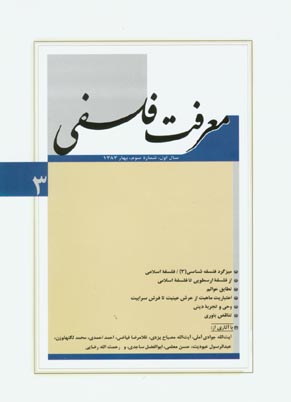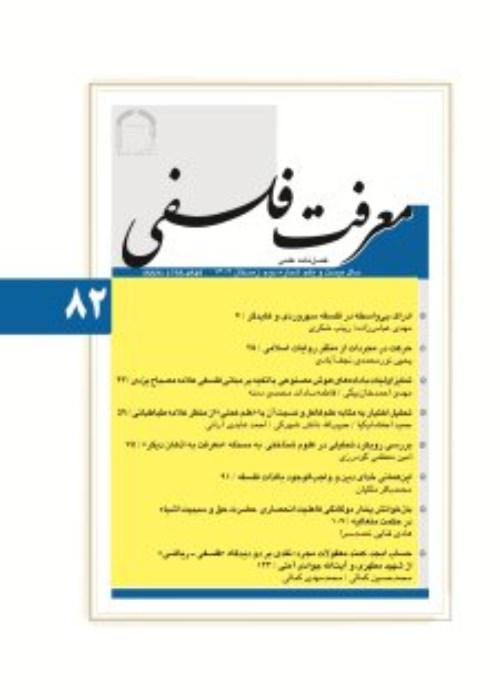فهرست مطالب

فصلنامه معرفت فلسفی
پیاپی 3 (بهار 1383)
- 160 صفحه، بهای روی جلد: 3,000ريال
- تاریخ انتشار: 1383/04/30
- تعداد عناوین: 8
-
صفحه 7
-
میزگرد فلسفه شناسی (3) / فلسفه اسلامی / با حضور آیت الله مصباح یزدی، استاد غلامرضا فیاضی، دکتر احمد احمدی، و دکتر محمد لگنه اوزنصفحه 11
-
صفحه 27این مقاله، که به عنوان پیام به همایش «ارسطو؛ پلی بین شرق و غرب» ارائه شده، در چند بخشتنظیم گردیده است: ابتدا به بیان هویت ارسطو و شخصیت فلسفی او و عواملی که در شکل دهیآن تاثیر داشته، پرداخته است، و به عوامل درونی از جمله نبوغ اندیشه و طهارت انگیزه، وعوامل بیرونی از جمله مهارت استاد و پرورش شاگردان مستعد در حوزه فلسفی او اشارهمی کند.
آن گاه پس از بیان معیار و عنصر محوری «اسلامی بودن علوم»، به معیار اسلامی بودن فلسفهمی پردازد. در ادامه، سیری اجمالی در فلسفه اسلامی دارد و مراتب گوناگونی برای صدق وصف«اسلامی» بر فلسفه ترسیم می کند. سپس به بحث عقلانیت در اسلام می پردازد و نمونه هایی ازتعقل گرایی اسلامی ارائه می دهد.
در پایان، سیری اجمالی در مکتب ارسطو دارد، نام گذاری فلسفه ارسطو به «مشائی» را فاقدپیام معرفتی می داند و پس از بیان برخی آراء ارسطو، به نقد آنها از دیدگاه فلسفه اسلامیمی پردازد.
کلیدواژگان: ارسطو، افلاطون، حکمت متعالیه، فلسفه اسلامی، عقلانیت، تعقل گرایی -
صفحه 55مبحث تطابق عوالم در حکمت متعالیه، متاثر از مبحث حضرات خمس در عرفان نظری است.
در این مقاله، ابتدا وجود خاص (یا فرد) ماهیت و وجود جمعی آن توضیح داده می شوند وسپس بر اساس تشکیک در ماهیت افراد طولی ماهیت و بر اساس تشکیک در وجود وجوداتطولی ماهیت تصویر می شوند. هم افراد طولی ماهیت، که به نظریه مثل افلاطونی می انجامند،و هم وجودات طولی ماهیت، هر دو، به نحوی نظریه تطابق عوالم را تبیین می کنند اما با توجهبه مقبول نبودن تشکیک در ماهیت، در حقیقت، وجودات طولی ماهیت اند که توجیه گر تطابقعوالم اند. در پایان مقاله، به قاعده «کل ما هو اشد وجودا، فهو اشد احاطه للمعانی و الماهیات»که بر وجودات طولی ماهیت متفرع است، و قاعده «بسیط الحقیقه کل الاشیاء»، که حالتخاصی از قاعده اول است، و سپس به تتمیم مسئله «ماهیت نداشتن واجب بالذات»، که نتیجهقاعده اخیر است، اشاره می شود.
کلیدواژگان: ماهیت، حقیقت، بسیط الحقیقه، واجب بالذات -
صفحه 89تفسیر اعتباریت ماهیت در نظر همه کسانی که قایل به اصالت وجود هستند، از جایگاه ویژه ایبرخوردار است؛ زیرا در این تفاسیر، فاصله ای از عینیت ماهیات با وجودات خاص خود تا سرابکلی بودن ماهیات وجود دارد و می توان به سه تفسیر رسید که در هر تفسیر نیز دو تبیین جزئی تروجود دارند و حاصل آنها شش تفسیر برای اعتباریت ماهیت قابل طرح و بررسی است:1. ماهیت عین وجود است؛ همچون صفات حق که عین ذات حقند، و ماهیت با این اتحاد با وجود،به عین وجود موجود می شود و ثبوت تحلیلی پیدا می کند.
2. ماهیت عین وجود است؛ همچون صفات حق، ولی با این اتحاد همچون وجود موجود نمی شود،بلکه فقط موجود حقیقتا بدان متصف می شود.
3. ماهیت حد وجود است و همچون سطح وحجم، که نحوه وجودجوهرند، نحوه ثبوتی وجود است.
4. ماهیت حد وجود است و همچون نقطه، که عدم است، هیچ نحو ثبوتی ندارد و صرفا جنبه عدمیدارد.
5. ماهیت سراب است، ولی سرابی که ساخته محض ذهن باشد نیست، بلکه از تعامل ذهن و نحوهموجودات حاصل می آید.
6. ماهیت سراب محض و ساخته صد درصد ذهن است و هیچ اثر و جای پایی در خارج ندارد.
کلیدواژگان: اعتبارات ماهیت، اطلاق وجود و موجود، حیث تقییدی، عینیت ماهیت، حدیت ماهیت، سرابیت ماهیت -
صفحه 107یکی از مسائل مطرح در حوزه دین پژوهی نوین، ماهیت وحی و تجربه دینی است. موضوع،بررسی این مسئله است که آیا می توان وحی قرآنی را تجربه دینی پیامبر تلقی کرد؟ این نوشتاردر پی آشکار ساختن نسبت میان این دو می باشد. برای رسیدن به این مقصود، لازم است ابتداچیستی وحی و تجربه دینی در اندیشه مسیحی به بحث گذاشته شود. بدین منظور، دیدگاه هایدوگانه درباره وحی و دیدگاه های سه گانه ماهیت تجربه دینی و دیدگاه صحیح بررسیگردیده اند، سپس به بیان چیستی وحی قرآنی پرداخته شده است. در این میان، کاربردهای متعددوحی در قرآن و سپس مراد از وحیانی بودن آموزه های آن بررسی شده اند. در فرجام مقاله،ملاحظاتی درباره نوع پیوند وحی قرآنی با تجربه دینی ذکر گردیده است.
کلیدواژگان: فلسفه دین، وحی، تجربه دینی، الهام، تجربه، قرآن، کتاب مقدس -
صفحه 133مقاله حاضر اثر گراهام پریست، منطقدان و نویسنده معاصر است. وی در این مقاله می خواهدبر این اجماع که «اجتماع نقیضین محال است»، نقطه پایان نهاده، آن را نه تنها محتمل، بلکهمحقق نشان دهد. برای این منظور، به مواردی اشاره می کند که تناقض نما هستند و این موارد رامختص به زمان و مکان خاص نمی داند. از سویی دیگر، ادله اقامه شده بر استحاله اجتماع راخالی از اشکال نمی بیند. آنگاه وی نتیجه می گیرد که برخی تناقض ها محال نیستند و به تعبیردیگر، برخی امور هم صادق اند و هم کاذب.
مترجم به نقد این دیدگاه پرداخته و از استحاله اجتماع نقیضین دفاع می کند. برای این منظور،نخست به بررسی ادله ارسطو در این باب پرداخته، آنها را نه استدلال اصطلاحی، بلکه تنبه بریک امر بدیهی تلقی کرده، به توجیه برخی موارد مورد تمسک نویسنده اشاره می کند. سپسنتیجه می گیرد که استحاله اجتماع نقیضین برای هر عقلی و عاقلی در هر ظرف و مکانی بدیهیاست و تنها مشکل عدم تصور درست آن می باشد.
کلیدواژگان: تناقض باوری، فراسازگاری، ارتفاع نقیضین، عقلانیت، پارادوکس، اجتماع نقیضین
-
Page 55Philosophy has been influenced by the argument about the five worlds in theoretical mysticism, namely the world of Divinity, the world of forms, the world of bodies, the world of abstracts, and the world of intellect. Addressing this question, the author first explains the special (or individual) (mode of) existence of quiddity, as well as its collective existence. Then he discusses the longitudinal cases of quiddity on the basis of the gradation in quiddity, and the longitudinal existences of quiddity on the basis of the gradation in existence.Both the longitudinal cases of quiddity, which form the ground for Plato’s idea of “forms,” and the longitudinal existences of quiddity, explain the theory of the conformity of the worlds one way or another. Since the gradation in quiddity, is not acceptable, the longitudinal existences of quiddity, in fact, accounts for the conformity of the worlds. Finally, the article reviews the principle of “the stronger a thing is in its existence, the stronger is its hold of meanings and quiddities,” which stems from longitudinal existences of quiddity. Also, the principle of “simple (non-composite) reality is everything,” which is a particular state of the first principle, has been dealt with. The article goes on to supplement the issue of, “the necessary being’s lack of quiddity,” which is the product of the last principle.
-
Page 89In different interpretations of the conventionality of quiddity, there is a gap between regarding quiddities identical with their particular existences and marking quiddities as merely a mirage. The conventionality of quiddity can have three interpretations, each one of which has two sub-interpretations: 1. Quiddity is identical with existence, like the attributes of God, and quiddity, through such a union with existence, becomes existent. 2. Quiddity is identical with existence, the same way God's attributes are identical with Him. The difference is that quiddity does not become existent through this union, but only the existent is veritably qualified by it. 3. Quiddity is the boundary of existence; it is the positive quality of existence, like surface and mass which are qualities of substance. 4. Quiddity is the boundary of existence; it has no positivity, and is utterly negative, like zero, which is nothing. 5. Quiddity is a mirage (delusion), but it is not an absolutely mental product, rather it is the outcome of an interaction between mind and the quality of what exists. 6. Quiddity is utterly a mirage; it is totally a mental construct, which has no objective reference outside the mind.
-
Page 107One of the issues in the field of modern religious studies is the nature of revelation and religious experience. Here, the discussion revolves around the question as to whether the Qur’anic revelation can be considered as a religious experience by the Prophet. This essay seeks to clarify the relation between the two. To do so, it firstly addresses the Christian viewpoint about the “whatness” of revelation and religious experience. In this regard, it examines two views about revelation and three views about the nature of religious experience in order to reach a soundly based view. Next, it inquires into the Qur’anic revelation. The use of revelation in different Qur’anic contexts is surveyed, and the notion of revelatory Qur’anic teachings is explained. Finally, it introduces some observations about the kind of relation between the Qur’anic revelation and religious experience.
-
Page 133The article by Graham Priest, the contemporary logician and writer, seeks not only to deny the widely-held logical principle of non- contradiction (the principle that the conjunction of a proposition and its negation is impossible), but also to assert both the possibility and existence of contradictions. To affirm his position, he brings to light some paradoxical cases (propositions), which belong neither to any specific time nor place. He gives some examples from both western and eastern philosophies. On the other hand, he states that all arguments for the principle in question are prone to objections, and concludes that some contradictions are possible, or in other words, some propositions are both true and false. The author makes some remarks on Priest's view of contradictions, insisting that the conjunction of a proposition and is negation is impossible. To prove this, he examines some arguments given by Aristotle and considers them as hints at a self-evident matter instead of technical arguments. Elaborating on some propositions Priest uses to establish his position, the author concludes his discussion by stating that the impossibility of contradictions is self-evident to any mind or common sense, at any time or place. The only difficulty arises from the fact that it has been misconceived by some thinkers and much of its denial comes from the very misunderstanding.
-
AbstractsPage 155


